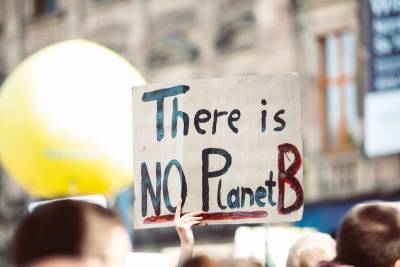The Importance of Sustainable Fashion in the Light of Climate Change
Tips and tricks.
The Importance of Sustainable Fashion in the Light of Climate Change
The negative impact of the fashion industry on the environment In a world grappling with the far-reaching impacts of climate change, the fashion industry stands at a crossroads. As the sector responsible for shaping our personal identities and expressions, fashion also plays a significant role in environmental degradation.

The Environmental Toll of the Fashion Industry:

A Fast Fashion Fallout
Fast fashion, driven by rapid production cycles and disposable clothing, has become emblematic of the industry's unsustainable practices. The allure of cheap and trendy garments often comes at a high cost to the environment. The following points underscore the environmental toll of fast fashion:
- Water scarcity: The fashion industry is a significant contributor to water scarcity, with textile wet processing operations being the second-largest polluter of water globally. The production of cotton, one of the most commonly used materials in the fashion industry, requires large amounts of water, which can lead to water shortages in regions where water is already scarce.
- Eutrophication: The use of synthetic fertilizers in cotton production can lead to eutrophication, a process in which excess nutrients in water bodies cause an overgrowth of algae and other aquatic plants, which can deplete oxygen levels and harm aquatic life.
- Chemicals: The fashion industry uses a wide range of chemicals in textile production, including dyes, bleaches, and finishing agents, which can be harmful to human health and the environment.
- Climate change: The fashion industry is a significant contributor to greenhouse gas emissions, with fashion production accounting for 10% of humanity's carbon emissions. The production of synthetic materials such as polyester, which is commonly used in fast fashion, is particularly harmful to the environment as it is made from non-renewable fossil fuels.
- Waste: The fashion industry is responsible for a significant amount of waste, with 85% of all textiles going to the dump each year. The disposal of textiles in landfills can lead to the release of methane, a potent greenhouse gas.
The negative impact of the fashion industry on the environment is significant, and it is essential to shift towards sustainable fashion practices to reduce this impact.
Sustainable Fabrics
Mushroom leather production video

- Mushroom Leather (Mycelium Leather):
Details:
Mushroom leather, also known as mycelium leather, is created using mycelium, the root structure of fungi. It's a natural and sustainable alternative to animal leather, with properties similar to traditional leather.
Companies:
One prominent company in this field is MycoWorks, which produces Reishi, a type of mushroom leather. They use agricultural waste and mycelium to create a versatile and eco-friendly material. - Pinatex:
Details: Pinatex is a non-woven textile made from pineapple leaf fibers. It's a byproduct of the pineapple industry and provides additional income for farmers while reducing agricultural waste.
Companies: Ananas Anam is the company behind Pinatex. They work closely with pineapple farming communities to create sustainable materials that promote economic growth.
- Recycled Polyester:
Details: Recycled polyester is made from post-consumer plastic bottles or other discarded polyester textiles. These materials are processed, melted, and spun into new fibers for fabric production.
Companies: Numerous fashion brands have incorporated recycled polyester into their collections. Patagonia is known for its commitment to using recycled materials in its outdoor clothing.
- Hemp:
Details: Hemp is a plant that requires minimal water and pesticides to grow. Its fibers are strong, durable, and can be woven into various fabrics.
Companies: Hemp Fortex focuses on creating sustainable hemp-based fabrics for fashion and apparel, contributing to the growth of the hemp industry.
- Econyl:
Details: Econyl is a regenerated nylon made from discarded fishing nets, fabric scraps, and other nylon waste. It's processed through a depolymerization and repolymerization process to create new nylon fibers.
Companies: Aquafil is a pioneer in the production of Econyl. They work with various partners, including fashion brands like Stella McCartney, to create sustainable products.
- Tencel (Lyocell):
Details: Tencel is a cellulose fiber made from wood pulp, often sourced from sustainably managed forests. The production process is environmentally friendly and results in a soft, breathable fabric.
Companies: Lenzing Group is a major player in Tencel production. They collaborate with fashion brands worldwide to integrate Tencel fibers into their collections.
- Cork Fabric:
Details: Cork fabric is derived from the bark of cork oak trees. The bark is harvested without harming the trees and naturally regenerates over time.
Companies: Corkor produces a range of cork-based products, including bags and accessories. They prioritize sustainability by using eco-friendly practices in their production.
- Soy Fabric:
Details: Soy fabric is made from soybean byproducts, specifically the protein left after soy oil extraction. It's known for its softness and moisture-wicking properties.
Companies: The Chinese company Suzhou Makeit Technology Co. Ltd. is known for its development of soy-based fabrics for clothing and home textiles.
- Banana Fiber:
Details: Banana fiber is extracted from banana plants' stems and is turned into a strong and lightweight fabric.
Companies: Green Banana Paper is an eco-friendly company that produces wallets, accessories, and paper products made from banana fibers in Micronesia.
- Seaweed Fiber:
Details: Seaweed fiber is derived from seaweed, a renewable marine resource. It has natural antibacterial properties and is biodegradable.
Companies: Algiknit is a startup that focuses on creating sustainable textiles from seaweed. They aim to reduce the environmental impact of the fashion industry.
- Milk Fiber:
Details: Milk fiber is made from milk protein, often casein, which is extracted from surplus milk that's not suitable for consumption. It produces a soft and silky fabric.
Companies: Qmilch, founded by Anke Domaske, is a pioneer in milk fiber production. They utilize innovative technology to turn milk into a wearable and sustainable material.
Pinatex from pineapple video

Sustainable Fabrics: Pioneering a Regenerative Fashion Landscape
Amid this environmental reckoning, sustainable fabrics have emerged as a beacon of hope, offering a counter-narrative to the unsustainable practices of fast fashion. These innovative materials prioritize responsible sourcing, production, and disposal, addressing the ecological and social implications of clothing production.
Innovative sustainable fabrics and the companies behind them are at the forefront of sustainable fashion. They're driven by a passion for reducing the environmental impact of the textile industry and providing consumers with ethical and eco-friendly choices for their clothing and accessories. It's exciting to see how these materials are revolutionizing the way we think about fashion and sustainability.
Here are some reasons why the shift to sustainable fabrics is crucial:
- Reduced Environmental Impact: Sustainable fabrics encompass a range of eco-friendly options, such as organic cotton, hemp, and recycled fibers. These materials require fewer resources and generate fewer emissions during production.
- Innovative Materials: Mushroom leather, Piñatex, and other materials mentioned earlier are examples of cutting-edge sustainable fabrics that challenge traditional notions of fashion materials.
- Circular Economy: Many sustainable fashion initiatives embrace circularity, aiming to extend the lifespan of garments through repair, reuse, and recycling.
- Ethical Production: Sustainable fabrics often come from sources that prioritize fair labor practices and worker well-being, challenging the exploitative norms prevalent in fast fashion.
- Consumer Awareness: As consumers become more environmentally conscious, the demand for sustainable fashion grows, urging brands to adopt eco-friendly practices.
The Call for Collective Action
The fashion industry's transition to sustainable fabrics requires a collective effort from designers, manufacturers, consumers, and policymakers. Here are actionable steps that can drive change:
Fast fashion is a major pollutant
The amount of clothing that ends up in landfills is a significant contributor to the environmental challenges posed by climate change. Here are a few eye-opening facts and figures that shed light on the scale of this issue:
Massive Waste Generation:
- According to the Ellen MacArthur Foundation, the equivalent of one garbage truck full of textiles is landfilled or incinerated every second globally.
- The United Nations estimates that the fashion industry is responsible for generating about 92 million tons of textile waste annually.
Low Utilization Rates:
- A report by McKinsey & Company reveals that only about 60% of all clothing items are used for over a year, while 40% are discarded within a year of purchase..- The average number of times a garment is worn before being discarded has decreased by about 36% compared to 15 years ago.
Shortened Lifespan:
- The waste generated by the fashion industry has increased by 79% from 2000 to 2014, as stated in a report by the Ellen MacArthur Foundation..- The fast fashion business model, characterized by low-cost, rapidly produced garments, contributes to a culture of disposability and shorter lifespans for clothing items.
Environmental Impact:
- The Carbon Trust estimates that the carbon footprint of a single new cotton T-shirt is around 6.8 kg CO2e (carbon dioxide equivalent), which is equivalent to driving a car for about 35 miles..- The environmental impact of clothing waste extends beyond landfills. Synthetic fabrics, like polyester, shed microplastics when washed, contributing to plastic pollution in oceans.
Delayed Decomposition:
- Natural fibers like wool and cotton can take months to years to decompose in landfills due to the lack of oxygen and microbial activity..- Synthetic fibers, such as polyester and nylon, can take decades to hundreds of years to break down, releasing microplastics in the process.
Global Consumption Trends:
- The global fashion industry produced an estimated 2.1 billion metric tons of greenhouse gases in 2018, equivalent to the emissions of France, Germany, and the United Kingdom combined..- Reports suggest that clothing production has roughly doubled from 2000 to 2014, with the number of garments purchased annually per person also doubling during the same period.
These facts and figures underscore the urgent need for a shift in the way we approach clothing production, consumption, and disposal. The staggering amount of clothing discarded in landfills exacerbates climate change and highlights the unsustainable nature of the fast fashion industry. Initiatives to promote circular fashion, sustainable materials, and conscious consumer behavior are crucial to addressing this issue and mitigating its impact on the environment.
Towards solutions: The concept of circular fashion

Circular fashion is a concept that has gained significant attention in recent years due to its potential to revolutionize the fashion industry's approach to sustainability and environmental impact.
1. Understanding Circular Fashion:
Circular fashion is a framework that aims to create a closed-loop system within the fashion industry, minimizing waste and maximizing the utilization of resources. Unlike the traditional linear fashion model (take-make-dispose), where clothing is discarded after a short lifespan, circular fashion promotes a continuous cycle of design, production, and usage, followed by responsible disposal and regeneration.
2. Key Principles of Circular Fashion:
Circular fashion rests on several principles:
- Design for Durability: Creating garments that are made to last through careful design, quality materials, and craftsmanship.
- Repair and Maintenance: Encouraging consumers to repair and maintain their clothing rather than discarding them at the first sign of wear and tear.
- Reuse and Secondhand Markets: Promoting the resale of pre-owned clothing through thrift shops, online platforms, and clothing swaps.
- Recycling and Upcycling: Transforming old or worn-out clothing into new products, reducing the need for raw materials.
3. Achieving Circular Fashion:
To move towards a circular fashion model, we can consider the following steps:
a. Sustainable Materials:
Choosing eco-friendly materials like organic cotton, recycled polyester, and innovative fibers can reduce the environmental impact of fashion production.
b. Efficient Production:
Streamlining production processes to minimize waste and energy consumption is crucial. Technologies like 3D knitting and zero-waste pattern cutting can be utilized.
c. Extended Lifespan:
Educating consumers about proper care, repair, and maintenance can significantly extend the lifespan of garments.
d. Resale and Secondhand Markets:
Supporting the growth of secondhand markets and online platforms for buying and selling pre-owned clothing can contribute to circularity.
e. Collaborative Consumption:
Promoting the idea of borrowing or renting clothing for special occasions can reduce the demand for new items and help mitigate overconsumption.
f. Recycling and Upcycling:
Investing in recycling technologies that can transform old textiles into new fibers and fabrics can close the loop even further.
g. Consumer Mindset:
Encouraging consumers to prioritize quality over quantity and to be mindful of their purchasing decisions can drive demand for sustainable fashion.
h. Industry Collaboration:
Fashion brands, manufacturers, policymakers, and consumers need to collaborate to create a supportive ecosystem for circular fashion to thrive.
4. Challenges and Future Outlook:
While circular fashion presents a promising solution, challenges like scaling up recycling technologies, changing consumer behavior, and adapting business models remain. However, the growing awareness about sustainability and the increasing demand for ethical fashion suggest a positive trajectory for circular fashion in the future.
Circular fashion offers a revolutionary approach to making the fashion industry more sustainable by emphasizing durability, repair, reuse, and recycling. By embracing these principles and collaborating across the industry, we can work towards achieving a fashion system that's both stylish and environmentally responsible.
Image sources
Pexel
Pexel
Pexel